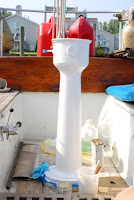
Winter is here and we've been getting the boat ready for the cold. The engine is cooled with sea water and so we have to flush it out lest it freeze and crack the engine block, sad christmas! I picked up some antifreeze and noticed it was good down to -53F or something. If it gets down to -53 anything in NY there's gonna be more problems than just out little engine!
So, in order to prevent hell, or
Satan from freezing over we put in 3 gallons of the purple stuff(tm) Conveniently the sea water strainer hose could be unshipped and plunked right into the jug of antifreeze. This was nice as I could fire up the engine and let it draw on its own. Otherwise it would be a 2 person job involving funnels, hoses, and some duct tape, I'm sure.
With the engine put to bed we are focusing now on adding insulation to keep the heat in and cold out. Heat is provided by a Dickinson Newport diesel heater. It pretty awesome, I tell you what! It burns the same diesel our engine does so luckily we won't have to mess about with separate tanks and multiple fuels onboard. The main fuel tank had a second supply fitting already so we just tapped into that. Otherwise, we would have had to add a tee and that could cause fuel starvation to the engine potentially. Not that we're planning on venturing out in this weather, but at least we followed directions.
The top of the heater gets nice and hot and here I am reheating a bowl of yummy lentil soup. Having a window in the front is nice and adds a touch of cozy atmosphere. We've been adding reflectix insulation around the boat- behind lockers and settees and in cabinets. The boat is not well insulated so any little bit we can do helps out alot.
Its been in the low 30's lately and the heater has been doing a pretty good job. We've had to figure out the best way to balance the fuel and air mix to get a good clean burn, and we're still learning how to cope with steady winds and downdrafts. Once in a while we'll turn on the oil filled radiator to add a little more heat. Hopefully more insulation will eliminate the need for it though as electricity is not cheap around here.
 Well, its the first snowfall of the year, and the first snowfall we've had on our boat.
Well, its the first snowfall of the year, and the first snowfall we've had on our boat.














































